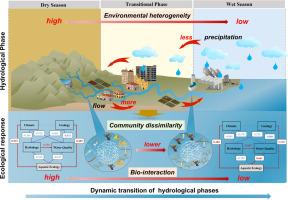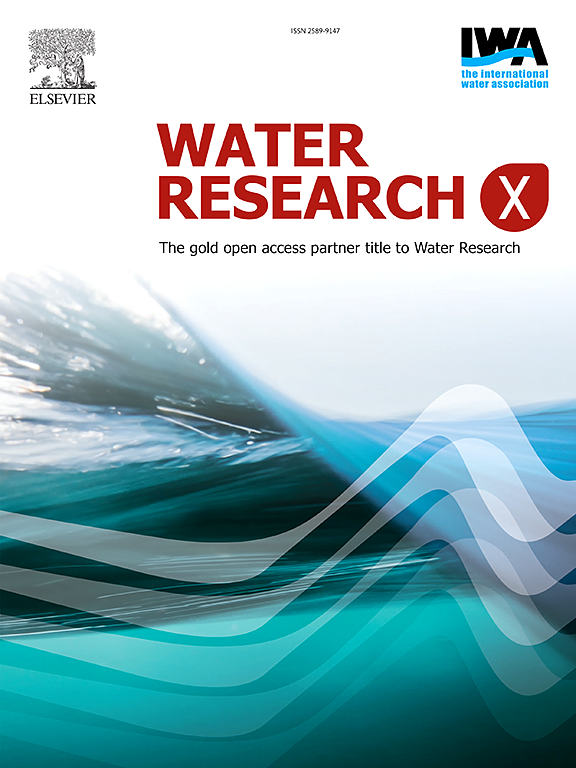Hydrological phase-driven management in semi-arid watersheds: Linking plankton assembly dynamics and adaptive resilience strategies
IF 8.2
2区 环境科学与生态学
Q1 ENGINEERING, ENVIRONMENTAL
引用次数: 0
Abstract
Semi-arid river basins, characterized by pronounced hydrological seasonality and anthropogenic pressures, face escalating threats to aquatic ecosystems under climate change. This study investigated the Dahei River Basin, a critical Yellow River tributary in Inner Mongolia, to unravel the coupled impacts of climate, geology, hydrological pulses and water quality degradation on eukaryotic plankton communities. Using α/β-diversity, dispersal-niche continuum index (DNCI), co-occurrence networks, and Partial Least Squares Path Modeling (PLS-PM) across dry-wet seasons and habitats, key findings emerged: (1) Urban wastewater inputs create multidimensional resource gradients that drive niche expansion in rivers, challenging the conventional paradigm of reservoir-dominated niche variation. (2) Hydrological pulses asymmetrically regulate trophic dynamics: wet-season runoff enhances phytoplankton dispersal, while zooplankton utilize dormant egg banks for resilience. This seasonality also alters network stability, with wet-season connectivity increases cascade risks and dry-season modularity enhances disturbance buffering. (3) The PLS-PM analysis further clarified that alternating wet-dry phases reconfigure ecological pathways. These findings advanced understanding of semi-arid aquatic ecosystems by decoupling phase-specific stressor pathways. Based on these findings, we established a "hydrological phase-responsive framework" (HPRF) that integrates empirical results with management needs for semi-arid watersheds, emphasizing that restoration must dynamically align with wet-dry transitions for ecological integrity in water-scarce regions. This work advances frameworks for balancing ecological integrity and urbanization in water-scarce regions.

半干旱流域水文阶段驱动管理:浮游生物聚集动态与适应性恢复策略的联系
气候变化背景下,以水文季节性和人为压力显著为特征的半干旱流域水生生态系统面临日益严重的威胁。本研究以内蒙古黄河重要支流大黑河流域为研究对象,揭示了气候、地质、水文脉动和水质退化对真核浮游生物群落的耦合影响。利用α/β-多样性、分散-生态位连续指数(DNCI)、共生网络和偏最小二乘路径模型(PLS-PM),研究发现:(1)城市污水输入产生了多维资源梯度,推动河流生态位扩展,挑战了水库主导的生态位变化的传统范式。(2)水文脉冲不对称调节营养动力学:雨季径流促进浮游植物扩散,而浮游动物利用休眠卵库增强恢复力。这种季节性也改变了网络的稳定性,雨季的连通性增加了级联风险,旱季的模块化增强了干扰缓冲。(3) PLS-PM分析进一步阐明了干湿交替对生态路径的重构作用。这些发现通过解耦特定阶段的应激源途径,促进了对半干旱水生生态系统的理解。基于这些发现,我们建立了一个“水文阶段响应框架”(HPRF),该框架将经验结果与半干旱流域的管理需求相结合,强调恢复必须动态地与缺水地区的生态完整性干湿过渡保持一致。这项工作推进了在缺水地区平衡生态完整性和城市化的框架。
本文章由计算机程序翻译,如有差异,请以英文原文为准。
求助全文
约1分钟内获得全文
求助全文
来源期刊

Water Research X
Environmental Science-Water Science and Technology
CiteScore
12.30
自引率
1.30%
发文量
19
期刊介绍:
Water Research X is a sister journal of Water Research, which follows a Gold Open Access model. It focuses on publishing concise, letter-style research papers, visionary perspectives and editorials, as well as mini-reviews on emerging topics. The Journal invites contributions from researchers worldwide on various aspects of the science and technology related to the human impact on the water cycle, water quality, and its global management.
 求助内容:
求助内容: 应助结果提醒方式:
应助结果提醒方式:


